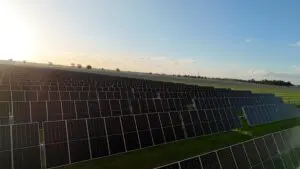
Gorgo/Wikipedia
Government of Alberta posts request for information to explore the possibility of using solar energy to meet half of its energy needs, replacing existing green energy contracts that are set to expire.
The government of Alberta, a province in Western Canada, has this week posted a Request for Information (RFI) to obtain advice on the feasibility of using solar energy to power 50% of government operations.
Despite being Canada’s fourth-most populous province, Alberta currently has very minimal solar capacity installed, with the bulk of PV progress in the country currently centered largely on Ontario. However, with existing green energy contracts set to expire by the end of next year, ministers have eyed solar energy as a clean way to generate the 135,000 MWh of power required under the two green energy contracts.
Alberta Infrastructure has been supplying the government with renewable facilities since 2009, chiefly via wind power. But solar’s chance to shine has never been explored in the province, which boasts some of the best levels of irradiation in the nation.
“The Prairies have the best solar resources in Canada and our government is committed to providing opportunities for the emerging solar industry to take advantage of this natural resource,” said minister of environment and parks and minister responsible for the climate change office, Shannon Phillips.
John Gorman, CEO of CanSIA (the Canadian Solar Industries Association), welcomed the plans. “There is no doubt that solar electricity will become an important component of Alberta’s decarbonized and diversified electricity supply mix as the cost of our technology continues to decline,” he said, adding that a solar farm able to meet half of the Government of Alberta’s power needs would also deliver a number of other ‘firsts’ in the province.
“It would mean Canada’s first 50% solar-powered government; Western Canada’s first large-scale solar farm; Alberta’s first utility-scale solar jobs. The success of this initiative will secure the government and public confidence in a larger future role for solar energy in Alberta.”
The RFI was issued on Thursday and will be open for three weeks. Currently in Alberta there exist three electricity contracts that provide 100% of the Alberta government’s power needs across its 1,500 government-owned buildings.
However, one of these contracts expires this December, and the other next year. If these two were to be replaced with solar, it would mean a ten-fold increase in the capacity of deployed PV in the province.
Alberta is one of the chief supply hubs for Canada’s lucrative but ecologically unsound crude oil and oil sands industries, and as such has long had a solar blindspot, particularly when compared to Ontario. However, Prime Minister Justin Trudeau has recently set out a plan to put a US$7.6 per tonne price on all carbon pollution by 2018 in an effort to drive down fossil fuel use in the country, and support the embrace of renewable sources.
Source: PV Magazine. Reproduced with permission.










